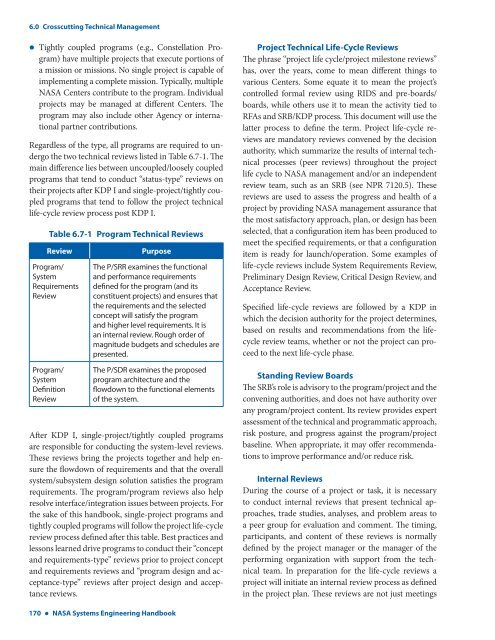NASA Systems Engineering Handbook
NASA Systems Engineering Handbook
NASA Systems Engineering Handbook
Create successful ePaper yourself
Turn your PDF publications into a flip-book with our unique Google optimized e-Paper software.
6.0 Crosscutting Technical Management<br />
Tightly coupled programs (e.g., Constellation Program)<br />
have multiple projects that execute portions of<br />
a mission or missions. No single project is capable of<br />
implementing a complete mission. Typically, multiple<br />
<strong>NASA</strong> Centers contribute to the program. Individual<br />
projects may be managed at diferent Centers. Te<br />
program may also include other Agency or international<br />
partner contributions.<br />
Regardless of the type, all programs are required to undergo<br />
the two technical reviews listed in Table 6.7-1. Te<br />
main diference lies between uncoupled/loosely coupled<br />
programs that tend to conduct “status-type” reviews on<br />
their projects afer KDP I and single-project/tightly coupled<br />
programs that tend to follow the project technical<br />
life-cycle review process post KDP I.<br />
Table 6.7‑1 Program Technical Reviews<br />
Review Purpose<br />
Program/ The P/SRR examines the functional<br />
System and performance requirements<br />
Requirements defned for the program (and its<br />
Review constituent projects) and ensures that<br />
the requirements and the selected<br />
concept will satisfy the program<br />
and higher level requirements. It is<br />
an internal review. Rough order of<br />
magnitude budgets and schedules are<br />
presented.<br />
Program/ The P/SDR examines the proposed<br />
System program architecture and the<br />
Defnition fowdown to the functional elements<br />
Review of the system.<br />
Afer KDP I, single-project/tightly coupled programs<br />
are responsible for conducting the system-level reviews.<br />
Tese reviews bring the projects together and help ensure<br />
the fowdown of requirements and that the overall<br />
system/subsystem design solution satisfes the program<br />
requirements. Te program/program reviews also help<br />
resolve interface/integration issues between projects. For<br />
the sake of this handbook, single-project programs and<br />
tightly coupled programs will follow the project life-cycle<br />
review process defned afer this table. Best practices and<br />
lessons learned drive programs to conduct their “concept<br />
and requirements-type” reviews prior to project concept<br />
and requirements reviews and “program design and acceptance-type”<br />
reviews afer project design and acceptance<br />
reviews.<br />
170 <strong>NASA</strong> <strong>Systems</strong> <strong>Engineering</strong> <strong>Handbook</strong><br />
Project Technical Life‑Cycle Reviews<br />
Te phrase “project life cycle/project milestone reviews”<br />
has, over the years, come to mean diferent things to<br />
various Centers. Some equate it to mean the project’s<br />
controlled formal review using RIDS and pre-boards/<br />
boards, while others use it to mean the activity tied to<br />
RFAs and SRB/KDP process. Tis document will use the<br />
latter process to defne the term. Project life-cycle reviews<br />
are mandatory reviews convened by the decision<br />
authority, which summarize the results of internal technical<br />
processes (peer reviews) throughout the project<br />
life cycle to <strong>NASA</strong> management and/or an independent<br />
review team, such as an SRB (see NPR 7120.5). Tese<br />
reviews are used to assess the progress and health of a<br />
project by providing <strong>NASA</strong> management assurance that<br />
the most satisfactory approach, plan, or design has been<br />
selected, that a confguration item has been produced to<br />
meet the specifed requirements, or that a confguration<br />
item is ready for launch/operation. Some examples of<br />
life-cycle reviews include System Requirements Review,<br />
Preliminary Design Review, Critical Design Review, and<br />
Acceptance Review.<br />
Specifed life-cycle reviews are followed by a KDP in<br />
which the decision authority for the project determines,<br />
based on results and recommendations from the lifecycle<br />
review teams, whether or not the project can proceed<br />
to the next life-cycle phase.<br />
Standing Review Boards<br />
Te SRB’s role is advisory to the program/project and the<br />
convening authorities, and does not have authority over<br />
any program/project content. Its review provides expert<br />
assessment of the technical and programmatic approach,<br />
risk posture, and progress against the program/project<br />
baseline. When appropriate, it may ofer recommendations<br />
to improve performance and/or reduce risk.<br />
Internal Reviews<br />
During the course of a project or task, it is necessary<br />
to conduct internal reviews that present technical approaches,<br />
trade studies, analyses, and problem areas to<br />
a peer group for evaluation and comment. Te timing,<br />
participants, and content of these reviews is normally<br />
defned by the project manager or the manager of the<br />
performing organization with support from the technical<br />
team. In preparation for the life-cycle reviews a<br />
project will initiate an internal review process as defned<br />
in the project plan. Tese reviews are not just meetings



